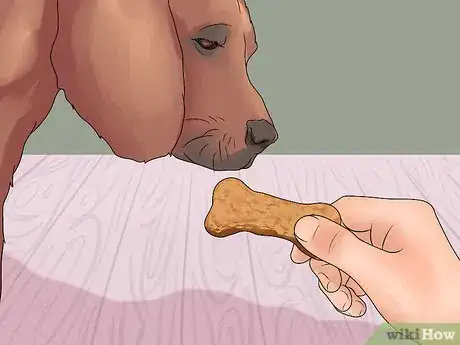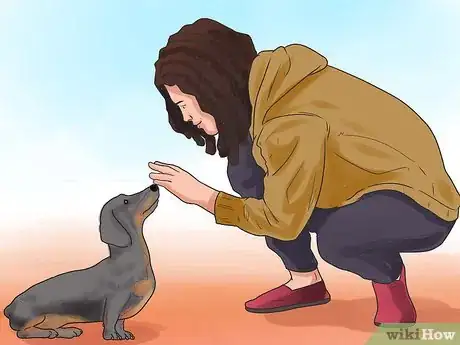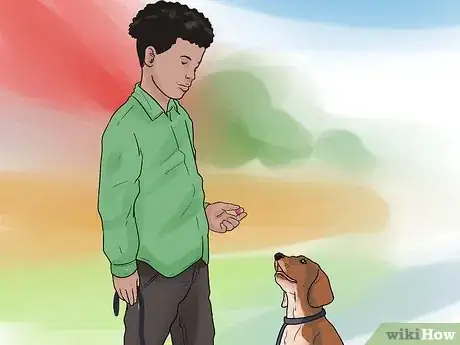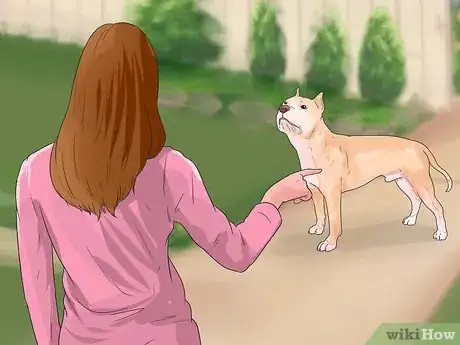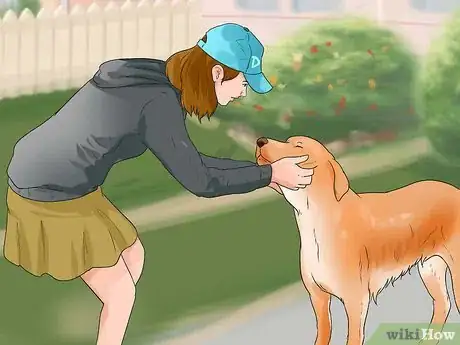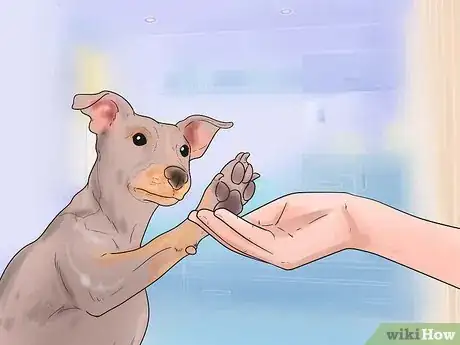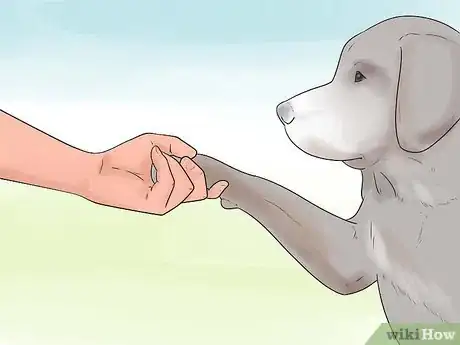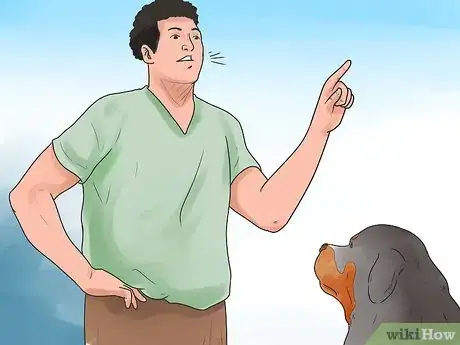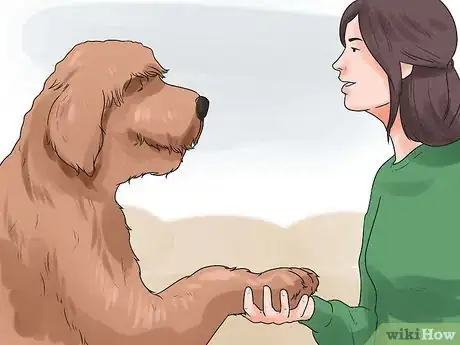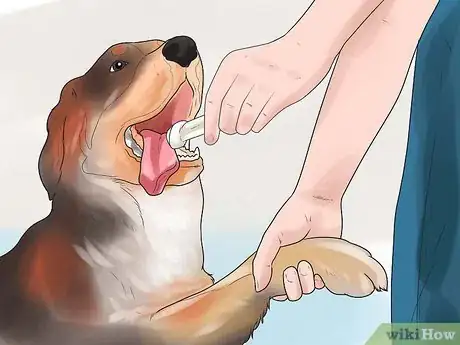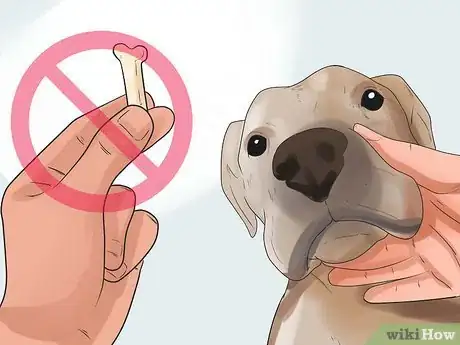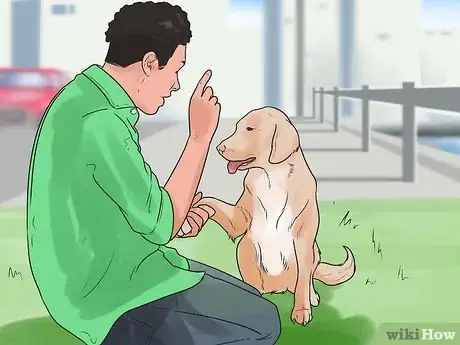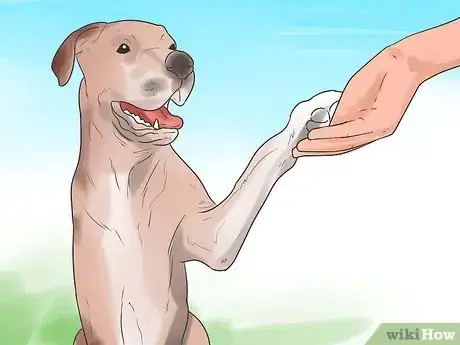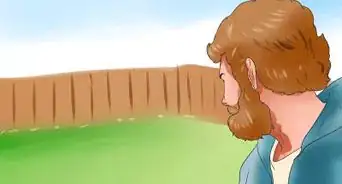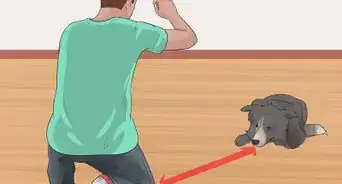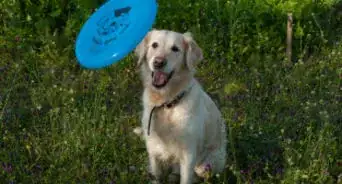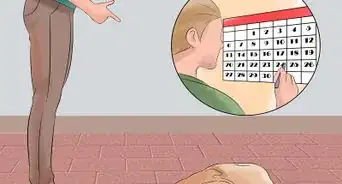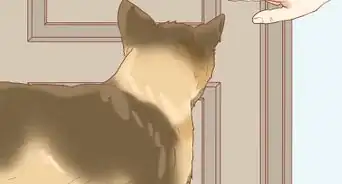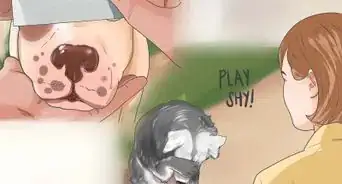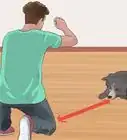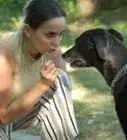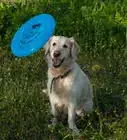This article was co-authored by Haley Yates. Haley Yates is a Dog Behavior & Training Expert and the Founder of Petra K9 Dog Training in San Jose, California. With several years of experience, she specializes in behavior modification as well as obedience training. She is an in-home dog trainer and teaches owners how to train their own dogs. She’s previously worked at several dog training facilities and taken classes to perfect her techniques.
wikiHow marks an article as reader-approved once it receives enough positive feedback. In this case, several readers have written to tell us that this article was helpful to them, earning it our reader-approved status.
This article has been viewed 379,847 times.
Teaching your dog to offer their paw to shake is a fun trick that can impress your friends. More importantly, this kind of training can help teach your dog obedience and deepen your bond. Your dog must first know how to sit before you can begin training them to shake hands. Start working with your dog today to teach them this easy command.
Steps
Initializing Training
-
1Pick out some treats for your dog. You will need to reward your dog when he shakes. Bite-sized treats are good for training because you can give your dog more of them without feeding them too many extra calories. Also consider what your dog likes and what will motivate them: does your dog like soft treats or hard treats? Is there a certain flavor that your dog seems to respond to more? Figure out which treat works best for your particular dog and have them on-hand for training.[1]
- Try making your own treats. These could be small pieces of cooked meat or even some fruits and vegetables.
- Don't overfeed your dog. Keep treat sizes as small as you can.
- Do not feed your dog the following food items, as they can cause poisoning or illness: avocado, chocolate, bread dough, grapes, raisins, hops, ethanol, moldy foods, macadamia nuts, xylitol, onions, garlic.[2]
-
2Have your dog sit down. The only way a dog can shake hands is if they are sitting. If your dog doesn't know how the command for sit, you will need to teach them to sit first.[3]
- Don't reward the dog with the treat here, as you are teaching him how to shake, not sit.
Advertisement -
3Present the treat to your dog. You won't be giving the treat to your dog just yet. For now, simply keep the treat in your left hand. Bring the treat in front of your dogs nose, showing it to him. Once you have his attention, close your fist around the treat.
- Don't let the dog grab the treat from you yet.
- Hold the treat between your thumb and your palm.
-
4Give the command "Paw." This is the command you will use to ask your dog to shake (you can also say something else like "Shake" if you prefer). Say this as you hold the fist with the treat in front of your dog.
-
5Say "Yes" when your dog begins to fidget. Once your dog realizes you have a treat in your closed hand, they will try to get it from you. When they make a move toward the behavior you want — such as lifting a paw to try and get the treat from your fist — say "Yes!" with a lot of enthusiasm and excitement and give them the treat.
- When your dog makes a move toward the behavior you want, immediately reward them with the treat.
- Ignore any other attempts your dog may make, such as sniffing or mouthing your hand.[4]
- Be patient.
- Practice this way a few times until the dog is reliably lifting their paw when you say "Paw."
-
6Reward the dog for shaking. Once your dog is lifting their paw on command, you will want to take it to the next step. You should begin reward the dog only as they do something closer to your goal of shaking. For instance, if your dog lifts their paw higher than before, that gets a "Yes!" and a treat, but not before then. Continue in this way until the dog is offering their paw.
-
7Take your dog's paw in your hand. Use this additional step only if your dog doesn't seem to paw at the treat in your hand. By picking up your dogs paw, and praising them during and after, you start to show your dog that pawing at your hand is rewarded.[5]
- Hold the paw for a few seconds before rewarding.
- Be gentle and move slowly.
Teaching the Verbal Command
-
1Introduce a verbal command. After your dog beings consistently pawing at the treat in your closed hand, you can start to introduce your preferred verbal command. Wait until your dog paws at your hand and issue the command while giving him the treat.
- Your command could be any word, but “Shake” or “Paw” are commonly used.
- Say your command clearly and loud enough to be heard by your dog.
- Issue your command at the exact moment the dog paws at your hand.
- Once you pick a command, don't change it, as this will confuse your dog.[6]
- Keep any command short. Generally only one word commands will be the best.[7]
-
2Start preemptively using your command. After you have begun using your verbal command when your dog paws at your hand, it's time to start saying it before it paws. As you move the hand with the treat towards your dog, say your command.
- This step helps him to realize the verbal command is now the signal to bring his paw up to shake.
- Ideally, your dog will bring his paw up as soon as you say your command.
- Only after he shakes should you reward him with the treat and praise him.
- If your dog doesn't bring his paw up at the command, try again until he does. If he still doesn't after about fifteen minutes, stop for a while and try again later. You don't want to frustrate your dog.
-
3Reward your dog only when it completes the command. Rewarding your dog for any other behavior will confuse your dog. Never reward him unless he has completed the command successfully, or else he might view your rewards as bribes.
- Avoid improper rewarding by always obtaining your dog's full attention before training.
- Don't get frustrated and give your dog the treat if he isn't doing the “shake” command as you asked. Giving up like this will send the message that if he sits and ignores you he will be rewarded.
- Realize that your dog is always paying attention. Any treat given to him will likely be associated with whatever he was doing at the time.
- Your dog wants to earn treats. Once he makes the connection that a behavior will earn him something tasty, he will be ready to behave in that way. This counts for both good or bad behavior. Be aware of this when you reward your dog.
Polishing the Trick
-
1Start removing treats. Eventually you will need to stop issuing treats for the behavior. Do this gradually by offering treats only every other time he performs the “shake” command. Substitute praise or other rewards, such as a walk or playtime, in place of treats.
- Keep practicing until you are positive he will “shake” without a treat.
- You can try offering an empty hand, with no treat, when first starting this step.
-
2Make it more challenging. Once you feel that your dog has mastered the “shake” command, try introducing challenges for it. Wait for a situation that usually bothers your dog, such as a visit to a busy place or someone coming to the door, and issue the command.
- The more situations you practice in, the better your dog will be able to perform this command.
-
3Try shaking with the other hand. Follow the same order of training as you did with the first hand. The main difference will be that you hold the treat in your opposite hand and only reward when your dog shakes with the desired paw.[8]
- Try using a different command word. If you used “Shake”, try using “Paw” for the opposite hand.[9]
Expert Q&A
Did you know you can get expert answers for this article?
Unlock expert answers by supporting wikiHow
-
QuestionHow do you train an aggressive dog? He won't sit and jumps up when I bring him food.
 Pippa Elliott, MRCVSDr. Elliott, BVMS, MRCVS is a veterinarian with over 30 years of experience in veterinary surgery and companion animal practice. She graduated from the University of Glasgow in 1987 with a degree in veterinary medicine and surgery. She has worked at the same animal clinic in her hometown for over 20 years.
Pippa Elliott, MRCVSDr. Elliott, BVMS, MRCVS is a veterinarian with over 30 years of experience in veterinary surgery and companion animal practice. She graduated from the University of Glasgow in 1987 with a degree in veterinary medicine and surgery. She has worked at the same animal clinic in her hometown for over 20 years.
Veterinarian A truly aggressive dog is dangerous and you should seek the advice of a certified dog behaviorist. If an aggressive dog jumps at you when you take in food, then shut the dog in a separate room, put the food down, and then let the dog in; however, many dogs jump up out of sheer excitement so this needs an expert to take a look to see what you're dealing with.
A truly aggressive dog is dangerous and you should seek the advice of a certified dog behaviorist. If an aggressive dog jumps at you when you take in food, then shut the dog in a separate room, put the food down, and then let the dog in; however, many dogs jump up out of sheer excitement so this needs an expert to take a look to see what you're dealing with. -
QuestionMy dog knows how to sit but chooses when to obey. What do I do?
 Pippa Elliott, MRCVSDr. Elliott, BVMS, MRCVS is a veterinarian with over 30 years of experience in veterinary surgery and companion animal practice. She graduated from the University of Glasgow in 1987 with a degree in veterinary medicine and surgery. She has worked at the same animal clinic in her hometown for over 20 years.
Pippa Elliott, MRCVSDr. Elliott, BVMS, MRCVS is a veterinarian with over 30 years of experience in veterinary surgery and companion animal practice. She graduated from the University of Glasgow in 1987 with a degree in veterinary medicine and surgery. She has worked at the same animal clinic in her hometown for over 20 years.
Veterinarian Reinforce her basic training with ongoing regular sessions for a few minutes, several times a day. Often a dog learns a command, such as "Sit", and we are lulled into believing we don't need to teach them any more. However, dogs need constant reinforcement of their learning, or they will "unlearn" what they already know. Simply beefing up the training to remind her should do the trick.
Reinforce her basic training with ongoing regular sessions for a few minutes, several times a day. Often a dog learns a command, such as "Sit", and we are lulled into believing we don't need to teach them any more. However, dogs need constant reinforcement of their learning, or they will "unlearn" what they already know. Simply beefing up the training to remind her should do the trick.
Expert Interview
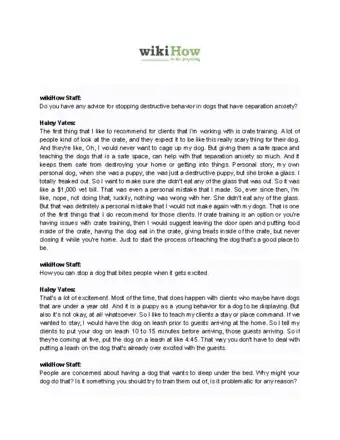
Thanks for reading our article! If you'd like to learn more about dog training, check out our in-depth interview with Haley Yates.
References
- ↑ http://www.dogs-day.com/tricks-and-fun/teach-give-paw-or-shake-hands
- ↑ https://www.aspca.org/pet-care/virtual-pet-behaviorist/dog-behavior/foods-are-hazardous-dogs
- ↑ https://www.aspca.org/pet-care/virtual-pet-behaviorist/dog-behavior/teaching-your-dog-sit
- ↑ http://www.dogs-day.com/tricks-and-fun/teach-give-paw-or-shake-hands
- ↑ http://www.dog-obedience-training-review.com/shake-a-paw.html
- ↑ http://www.dog-obedience-training-review.com/shake-a-paw.html
- ↑ http://www.humanesociety.org/animals/dogs/tips/dog_training_positive_reinforcement.html
- ↑ http://www.dog-obedience-training-review.com/shake-a-paw.html
- ↑ http://www.dogs-day.com/tricks-and-fun/teach-give-paw-or-shake-hands
About This Article
To teach your dog to shake hands, start by giving it a “sit” command or waiting for it to sit on its own. Once the dog sits, show it a treat, but don’t offer the treat yet. Give the dog a verbal command, such as “paw” or “shake,” and keep holding the treat in front of the dog. If your dog starts to fidget and ask for the treat, watch for any behaviors you want to reward. For instance, your dog may lift its paw to try to reach for the treat. If this happens, say “Yes!” in an excited voice and give your dog the treat. Keep doing this until the dog reliably lifts its paw whenever you say “paw” or “shake.” Next, start rewarding your dog as it gets closer to the goal behavior. For instance, if it lifts its paw higher or puts it on or in your hand, offer a treat. Say the command at the same time that the dog does the desired action. Then, move on to saying the command before the dog lifts its paw. If the dog completes the command, give it a treat. Eventually, your dog should start to respond to the command even without treats.
